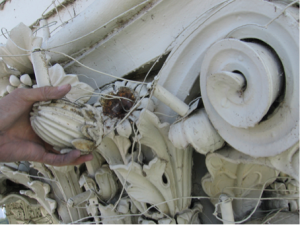Each week we’re bringing you an in-depth look at one of the standard conditions we encounter and document during inspections of buildings and civil structures.
Part 17: Metal Conditions
Metals used in the construction of buildings and civil structures include cast and wrought iron, steel, aluminum, copper, lead, zinc, tin, nickel, and various alloys. We document conditions for architectural metal (structural members, windows, spandrel panels, railings, sculpture and cast ornament, fasteners, etc.) and sheet metal (thin metal typically used as cladding for roofs and cupolas, flashing, and as ornament.)
Metal conditions include failed coatings; failed fasteners; corroded fasteners; prior repairs; various types of soiling; failed sealant; dented metal; and unsecured metal. We distinguish among three types of corrosion conditions: surface corrosion, pitted corrosion, and perforated corrosion. Some conditions affect only architectural metal: cracks, bent metal, failed flange connections and failed welds; and several conditions affect only sheet metals: failed folded seams, failed soldered seams, puncture damage and tearing.
Corrosion (and failure of fasteners through corrosion) is the principal mode of failure for architectural and sheet metals, especially iron and its alloys. Corrosion is accelerated when dissimilar metals are placed in contact with each other (galvanic corrosion). Corrosion of sheet metal roofing and cladding is accelerated by contact with atmospheric contaminants. When designed for exterior applications, cast and wrought iron were often protected with paint coatings. Loss of protective coatings (paint, plating, or galvanizing) leads to rapid corrosion of iron-based sheet metals. Some metals, such as copper and aluminum, are resistant to corrosion except by galvanic action. Sheet metals are also susceptible to impact damage, fatigue, and tearing.
See also: Pack Rust and Failed Coatings
Next in this series: Wood Conditions
Click here to see all posts in this series.
Click here for an index of all posts in this series, or download a pdf of the complete series.

